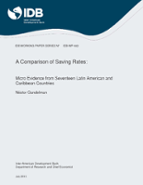A Comparison of Saving Rates: Micro Evidence from Seventeen Latin American and Caribbean Countries
Date
Jul 2015
Using micro data on expenditure and income for 17 Latin American and Caribbean (LAC) countries, this paper presents stylized facts on saving behavior by age, education, income and place of residence. Counterfactual saving rates are computed by imposing the saving behavior, the population distribution or the income distribution of two benchmark economies (the United States and Korea). The results suggest that the difference in national saving rates between LAC and the benchmark economies can mainly be attributed to differences in saving behavior of the population and, to a lesser extent, to differences in the distribution of the population by educational levels. Other demographic or income distribution differences are not quantitatively important as explanations of saving rates.



